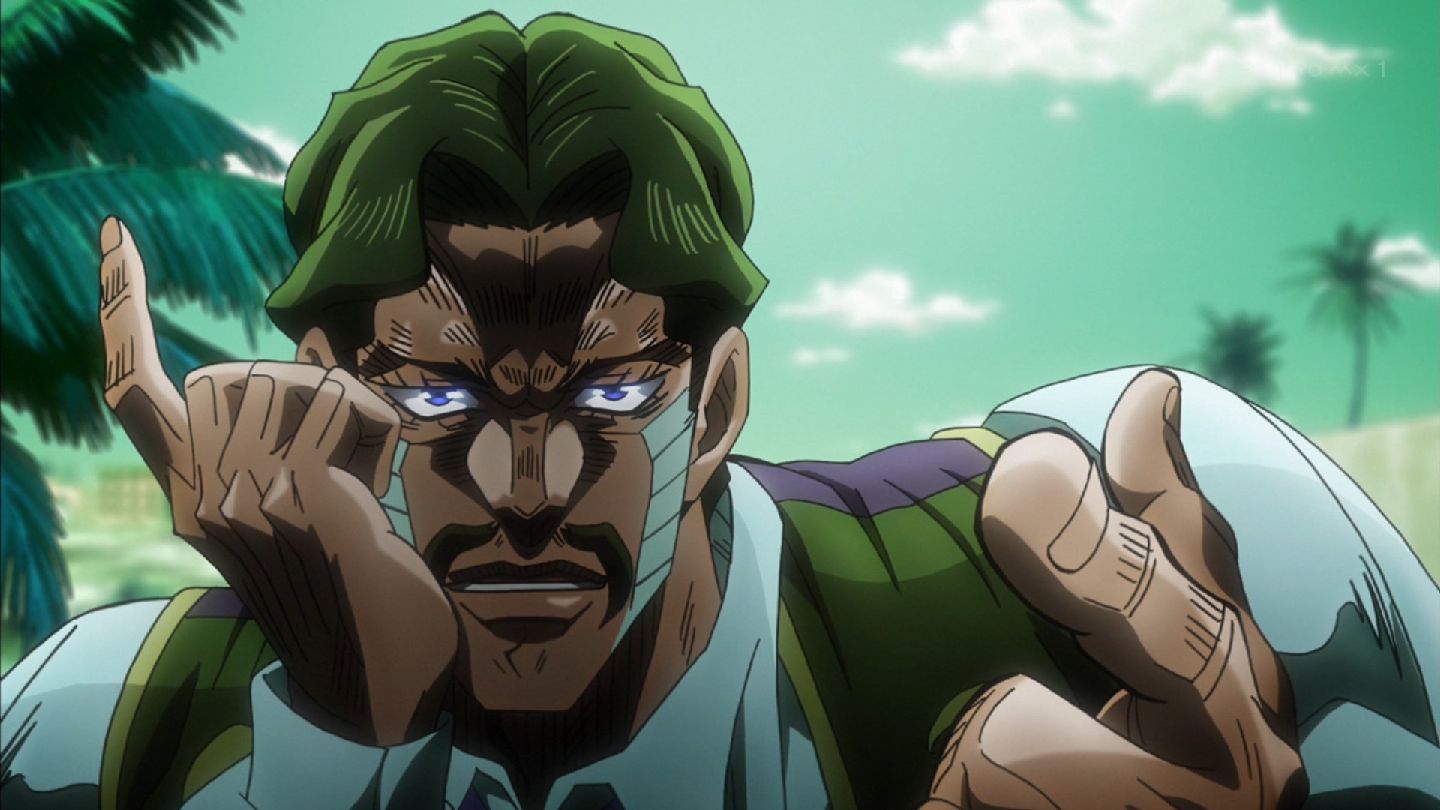Table of Contents Show
Shonen anime series are almost universally known for their gripping battles. When two shonen anime characters have a prize to win, a score to settle, or their pride to protect, you’d better believe that fists are about to fly. So many of the resulting clashes are famously engaging, usually involving wild powers with complex rules, split-second decisions, and dramatic, tense climaxes. In the best shonen anime fights, every little detail, from the characters’ abilities and personalities to the makeup of the battlefield, is pivotal.
This means that the battle is ultimately a way to show what’s interesting about the characters and the world they inhabit. Few shonen anime fights, though, boil down to boring punch-outs or beam clashes, resulting in a predetermined conclusion with no meaningful twists or turns. In that type of shonen anime fight, interesting character traits and worldbuilding details have no opportunity to come into play. Shonen anime can rely on spectacle to make these sequences engaging or artificially inject tension with sudden power-up moments, but discerning audiences will always see a boring, empty fight for what it really is.
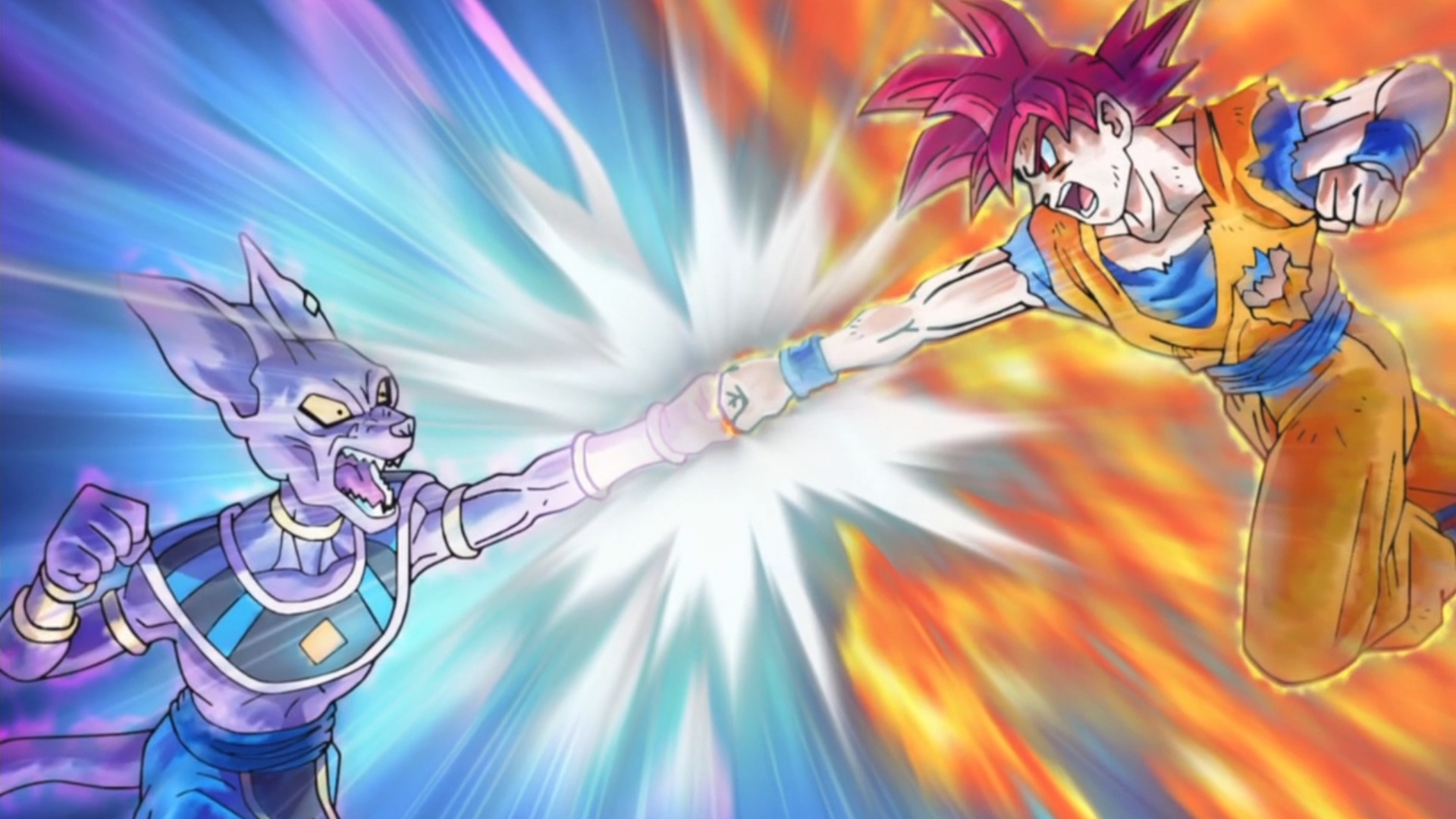
But what about when shonen anime characters can’t fight? Whether it’s due to an externally imposed rule or a peculiar power possessed by one of the characters, shonen anime characters occasionally need to resolve conflict using a different method. It’s shocking but true! These shonen anime confrontations have the potential to be extremely engaging and memorable. When a shonen anime can’t fall back on a straightforward fight, it’s forced to use the techniques that make the best shonen anime fights so great. These encounters necessitate coming up with unique rules for the particular situation and thinking about how the characters will interact with those rules with their unique abilities and personalities. That’s why analyzing these encounters is a great way to learn how to build better shonen anime fights and how to create quality narrative tension in general. So, let’s take a look at a few great non-combat clashes from a couple of fan-favorite shonen anime series.
How Exciting Is Watching A Candle Burn?
Hunter x Hunter (2011-2014; Yoshihiro Togashi) is a great place to start when considering a good shonen anime conflict. Very few of its confrontations are straightforward, and there’s almost always some set of externally imposed conditions to complicate things. It’s also no stranger to leaving the fighting by the wayside. Later on in the series, entire arcs don’t center around fighting at all; instead, they’re based around other types of competition.
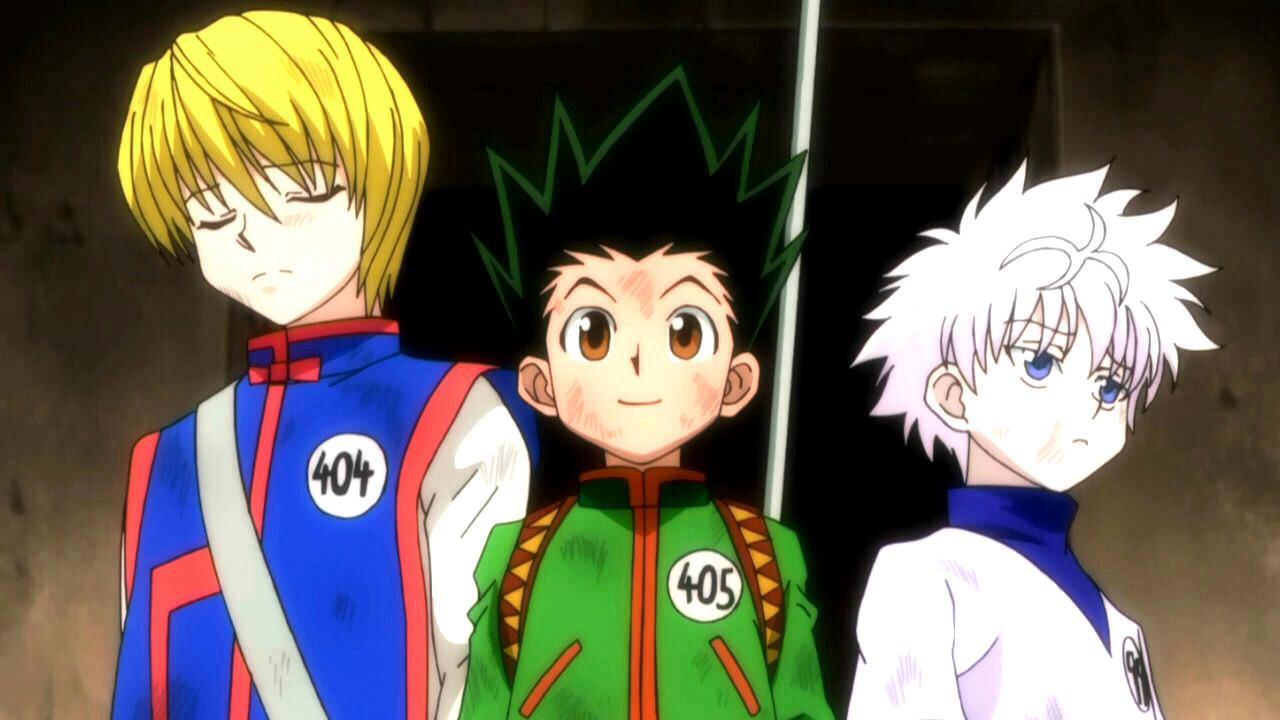
Even early on, this shonen anime explores contests other than fighting. The first story arc sees the series’s young protagonist, Gon, leaving his home to take the Hunter Examination and become a licensed Hunter like his estranged father. The various stages of the exam take many forms, from a marathon-length run to a cooking contest, before the third phase takes Gon to Trick Tower. In the tower, which is an exam site as well as a prison, Gon and his companions must face off against a group of prisoners in one-on-one competitions that the prisoners choose. Gon’s opponent is Sedokan, a scrawny serial bomber who readily admits that he doesn’t have the physical strength to face Gon in a fight (hardly a typical shonen anime antagonist). Instead, he proposes a game where he and Gon both light candles, and the person whose candle goes out first loses. It seems like a simple game of luck — until, that is, Sedokan proffers one long candle and one short candle and asks Gon to choose which one he’d like to play with.
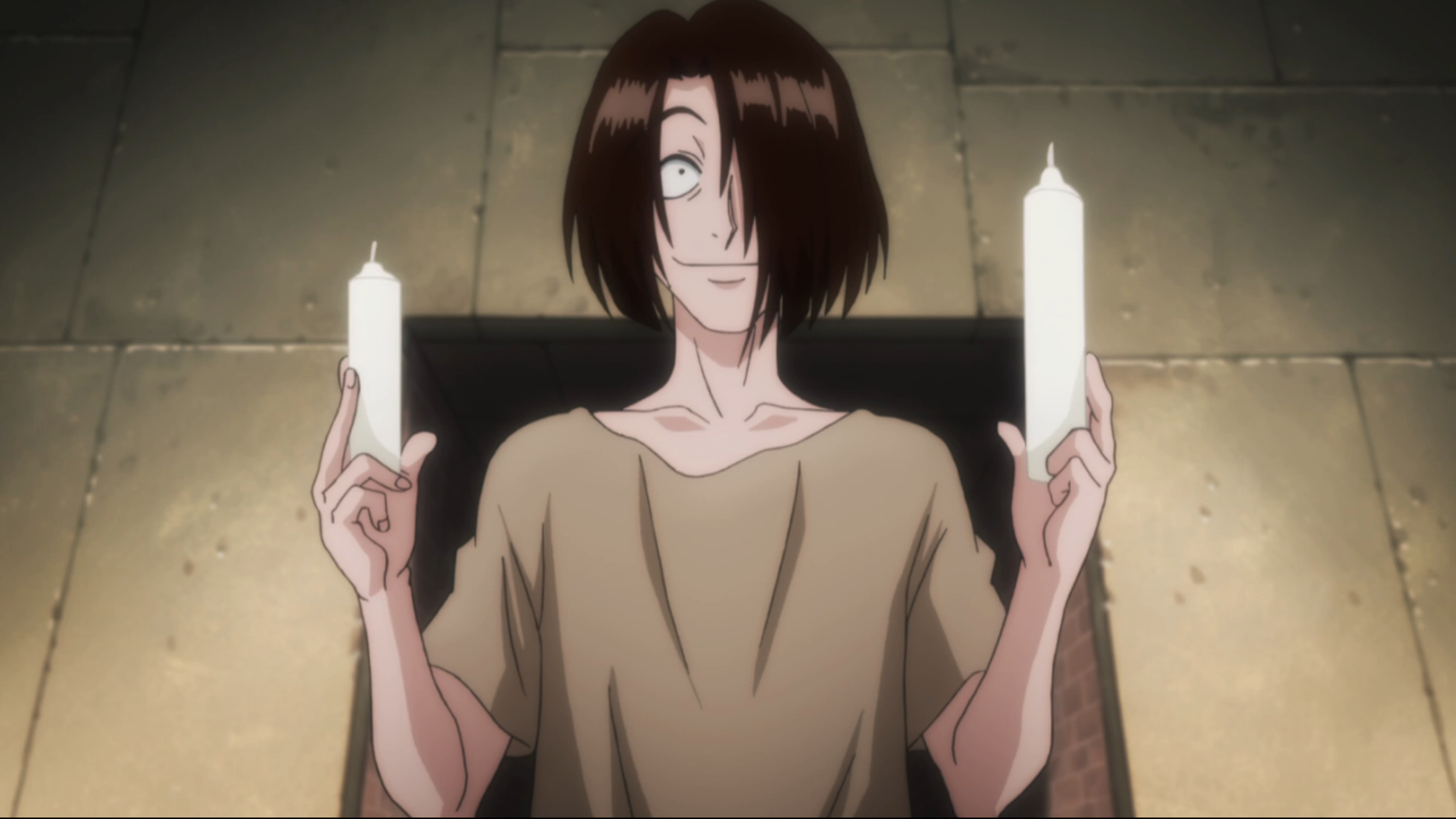
Suddenly, the challenge has become a complex, psychological puzzle. Common sense would dictate that the longer candle would stay lit longer. But then there’s the possibility that Sedokan has tampered with the long candle to make it burn faster. But what if he already predicted that his opponent would predict a doctored long candle and doctored the short candle instead? For a tense couple of minutes, Gon’s companions ponder how many layers deep Sedokan’s predictions might go before ultimately trusting the decision to Gon’s instincts. Showing his straightforward way of thinking (he is a shonen anime protagonist after all), Gon picks the long candle, and the game begins.
Light It Up!
The tension mounts as Gon and Sekodan face one another with their candles in hand. Things escalate even further when a stiff wind kicks up from the gorge beneath the arena, forcing both competitors to watch their flames carefully. Since so much weight was placed on Gon’s simple decision between the short or long candle, the suspense couldn’t be higher.
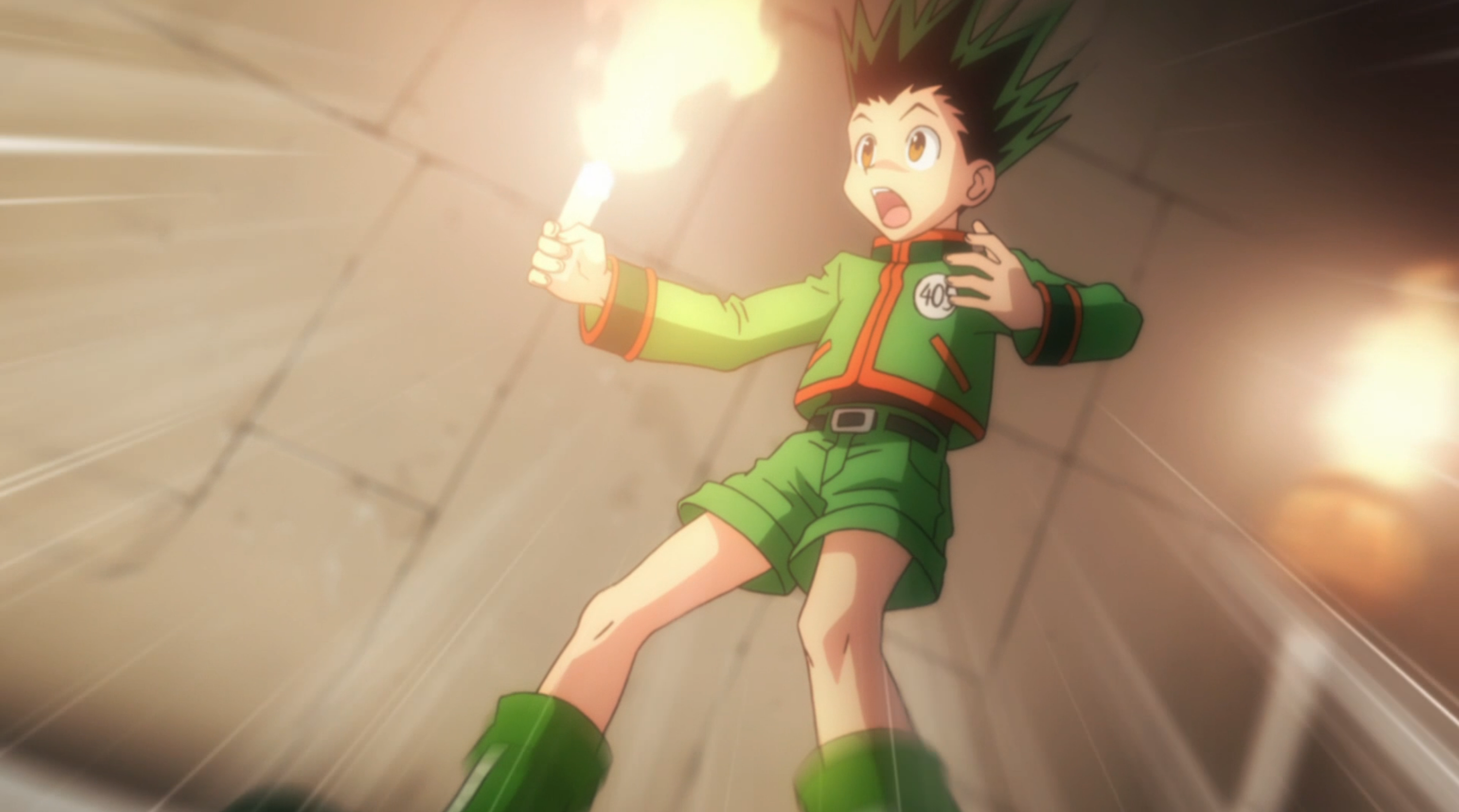
Suddenly, Gon’s flame flares upward, and his candle starts melting at an alarming rate. It looks like he made the wrong choice! Or did he? Sedokan reveals that he actually prepared four candles in an inner monologue, allowing him to give Gon a doctored candle no matter which one he chose. This brilliant reveal of previously hidden information is a perfect way to show off Sedokan’s scheming, devious nature and to make Gon’s predicament even direr. The finale of this battle of wits really shows off what makes non-combat encounters in shonen anime great and gives us a stunning impression of Gon’s character. Realizing that the wind won’t snuff out his candle’s now blazing flame, Gon simply puts his candle down and sprints over to Sedokan, extinguishing his opponent’s flame with a single tiny breath.
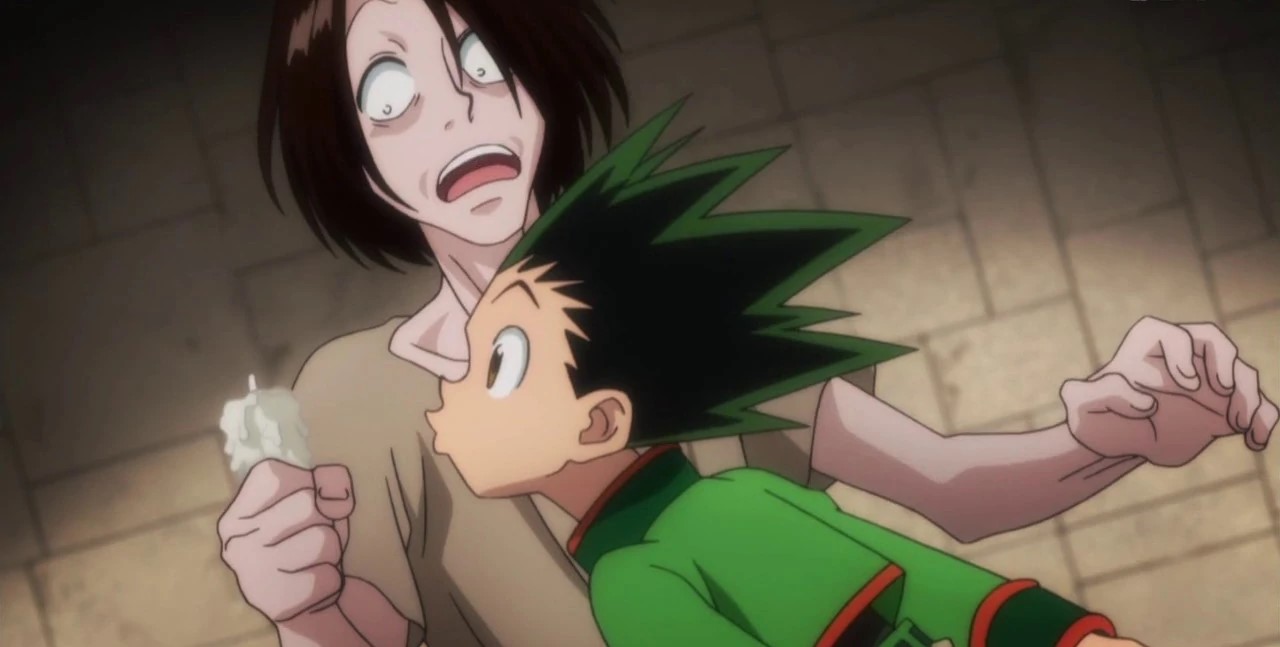
Notice that nothing in the initial rules of the contest specified how the candles needed to go out — Gon’s stunt is against the spirit of the game but technically allowed from the very beginning. It just took a straightforward but insightful mind like Gon’s to realize it. This fight is brilliant because it takes advantage of hidden information and specific rules and allows its main character to exploit a gap in the rules to pull out a surprising but satisfying victory. The tension is immense throughout, even though none of the characters are ever in any physical danger, and it’s more exciting and memorable than any simple shonen anime fistfight. The principles utilized in this conflict will continue to appear in other great non-combat encounters in shonen anime. The next one shows off all of the same techniques and uses its characters’ unique abilities to an incredible effect.
How Wild Can A Boat Race Get?
The next non-combat shonen anime encounter takes us to One Piece (1999-present; Eiichiro Oda), a show known for high-flying, swashbuckling pirate brawls. Even One Piece, though, knows how to put the combat away every once in a while, such as in the case of the famous Davy Back Fight. To alleviate any confusion, the Davy Back Fight is just called a “fight” — it isn’t a literal fight. Well, some parts of it involve fighting but not the part we’re focusing on here. It will all make sense in a second, trust me.
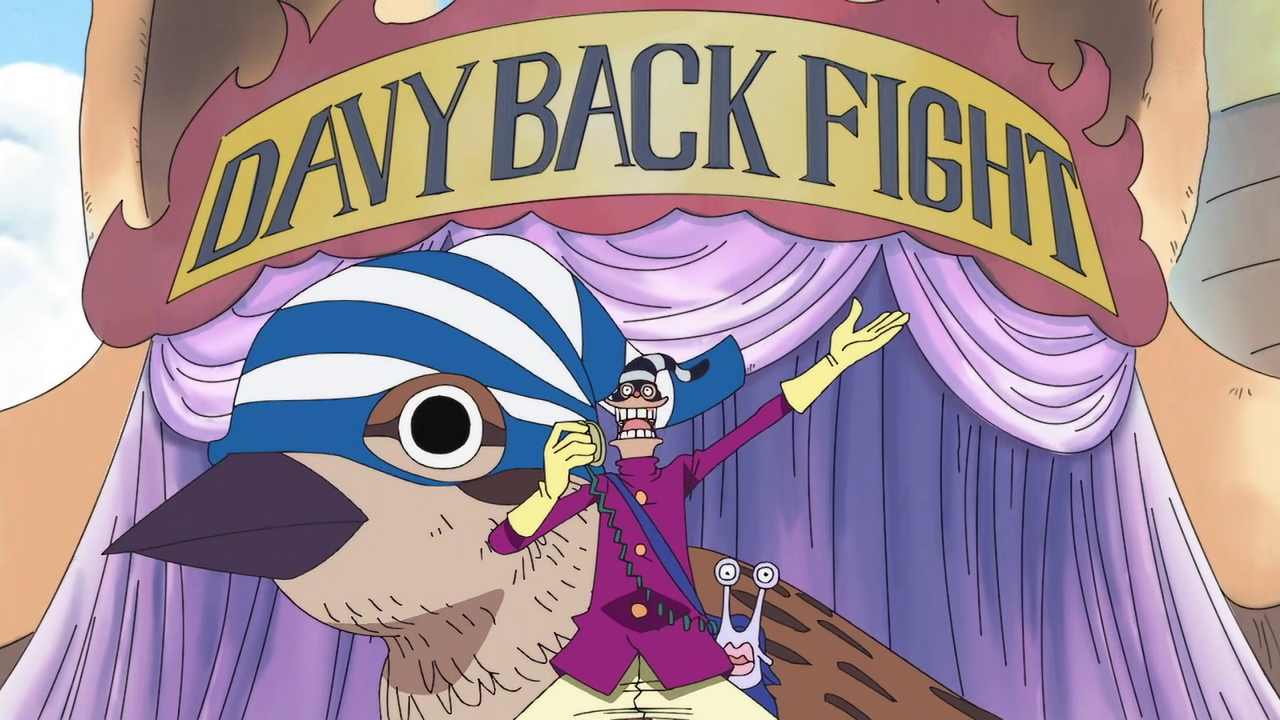
The animosity kicks off when protagonist Monkey D. Luffy and his Straw Hat Pirates arrive at a new island and come across a rival pirate group: the Foxy Pirates, led by the charmingly ridiculous Foxy the Silver Fox. Foxy challenges Luffy and his crew to a traditional pirate game known as the Davy Back Fight, in which the crews compete in three separate events. After each event, the winning crew gets to force one member of the losing crew to join them.
Your comrades and your pride are at stake. If you win, you get stronger, but if you lose, you lose big … it’s a vicious game!
Sanji — (( Oda, Eiichirō. “One Piece Vol 33.” VIZ Media. 2 Feb. 2010. ))
Luffy (a typical shonen anime protagonist who’s always up for anything) immediately agrees despite the risks, and the Davy Back Fight begins. We’re most interested in the first event in the game, the Donut Race because it’s another great example of a thrilling shonen anime situation involving zero combat.
Fast As You Can!
The Donut Race is a boat race around the island, which is surrounded by various natural obstacles and hazards. The catch is that you need to build your boat from scratch using only the wood from three empty casks and two oars. Fighting between the boats is allowed, but the main goal is to get around the island first. Luffy’s crewmates Ussop, Nami, and Robin volunteer to participate in the event. Ussop does his best in the boat construction phase, but the result isn’t much more than some barrels cut in half and tied together. In contrast, the Foxy Pirates display a major advantage in that they’ve participated in dozens of Davy Back Fights, so they’ve had plenty of practice constructing a decent boat out of a couple of barrels.
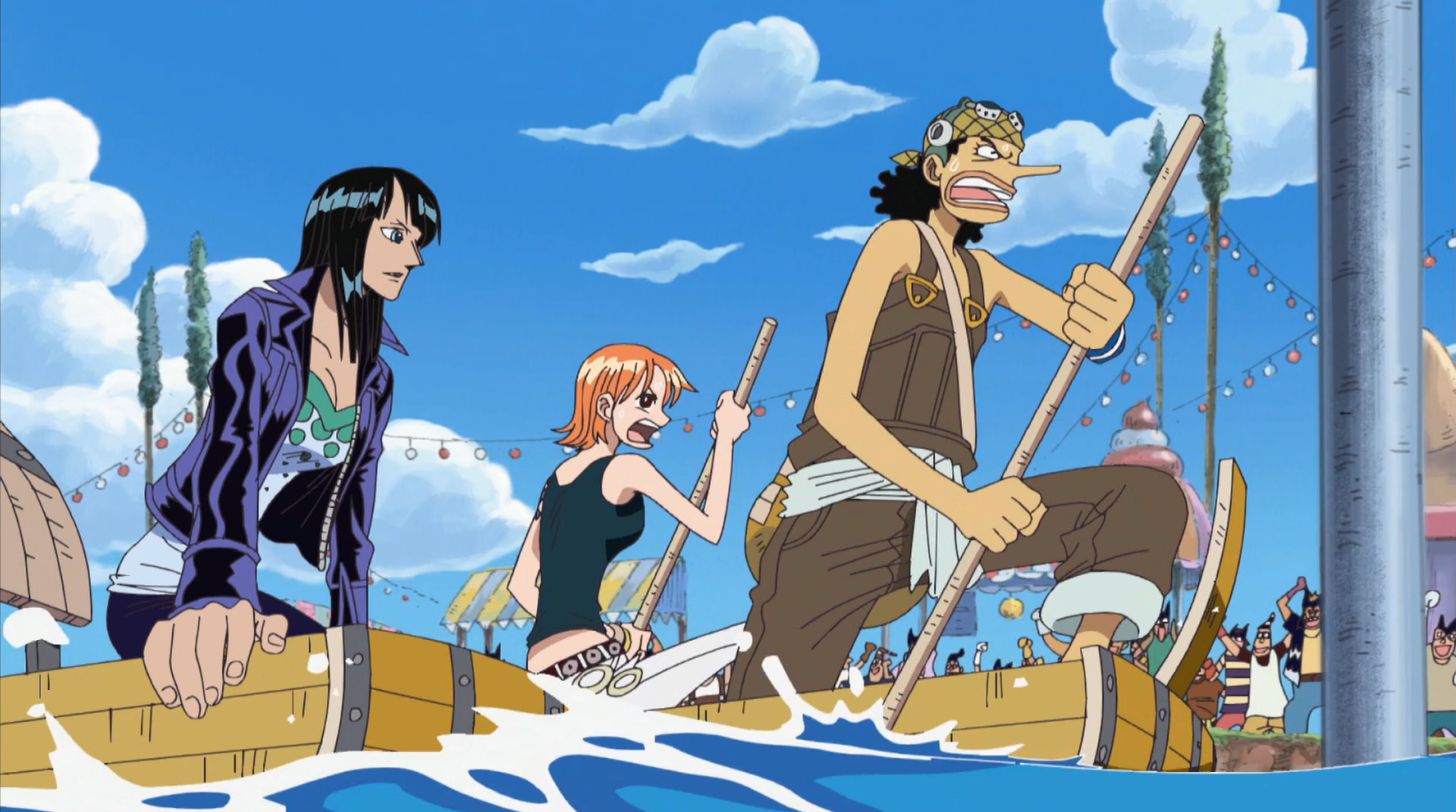
As soon as the race starts, One Piece reveals some great hidden information for a big surprise: the rules don’t say that the other crew members can’t interfere. As soon as the race starts, members of the Foxy Pirates begin to fire barrel bombs at Ussop’s boat from onshore. Before long, Foxy himself gets in on the action and begins to follow the boats along the shoreline, attempting to obstruct the Straw Hats at every turn. The rest of the race features many exciting ups and downs as teams pull ahead and fall behind. The entire sequence makes excellent use of the Straw Hat Pirates’ pre-established abilities. Robin, who has the ability to make her limbs sprout from any surface, is able to hassle the enemy from a distance. When a coral reef blocks the path around the island, Nami uses her navigational prowess to steer right through, leaving Foxy’s team in the dust.
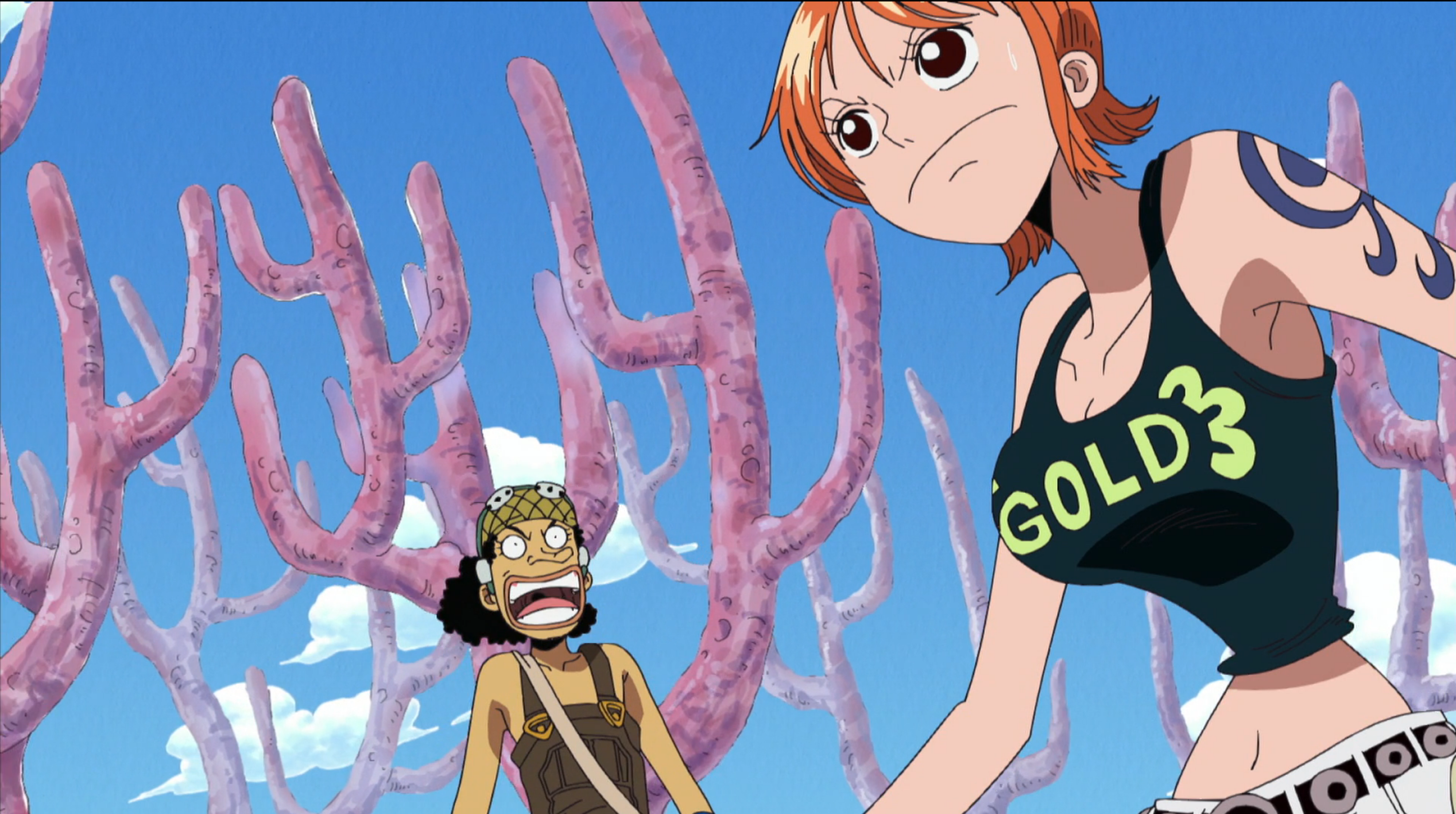
Meanwhile, Ussop uses a special item he picked up earlier in One Piece’s continuing story called the Impact Dial. It can propel the ship forward with unnatural bursts of speed, but it damages Ussop’s shoulder with each use. These types of utility-based skills are sometimes used in combat in One Piece, but they can really shine in a non-combat situation like the Donut Race. The conclusion of the race reveals yet another bit of shocking information. Having pulled way ahead, the Straw Hats are just about to cross the finish line when Foxy fires a mysterious beam at them. This is his own special power: the Slow-Slow Beam, which slows down anything it hits. With this assistance from their captain, the Foxy Pirates are able to just barely win the race.
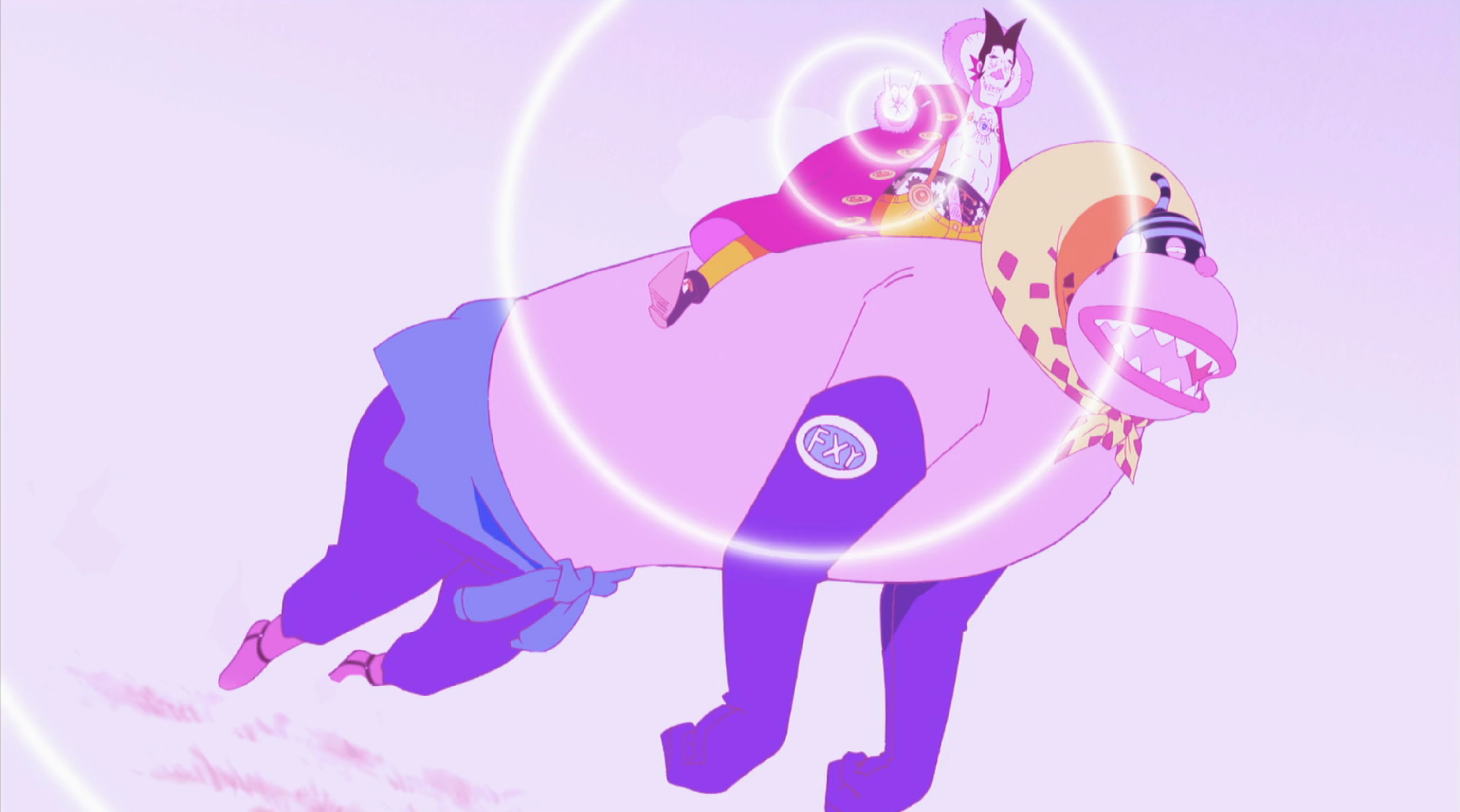
Foxy’s power is extremely important for the rest of the Davy Back Fight events, so introducing it at the climax of such a suspenseful sequence is another way that One Piece makes use of this non-combat encounter. But even better, this moment solidifies Foxy’s character as an unscrupulous schemer who’s perfectly willing to exploit loopholes in the rules as long as he wins. That’s what makes him such an entertaining shonen anime villain, and his interference in this simple race is what allowed him to shine.
The genius of interference, infamous for obstructing fair play … Foxy, the Silver Fox! And again today he wears an evil expression — his is the face of someone who’s just thought of something evil!
Itomimizu — (( Oda, Eiichirō. “One Piece Vol 33.” VIZ Media. 2 Feb. 2010. ))
How Thrilling Is A Game Of Poker?
This final encounter is the crème de la crème of non-combat conflicts in shonen anime. In terms of creating exploitable rules, using hidden information to create surprises, and making ingenious use of characters’ pre-established abilities, few shonen anime fights can come close to the wagers and wiles of D’Arby the Gambler. D’Arby hails from JoJo’s Bizarre Adventure: Stardust Crusaders. In this third story arc of the classic and expansive shonen anime series JoJo’s Bizzare Adventure (2012-present; Hirohiko Araki), Jotaro Kujo must travel to Egypt and kill the villainous Vampire DIO in order to save his mother from a magical affliction. Jotaro (as well as all of his allies and the enemies DIO sends against them) has a Stand or a unique psychic ability.
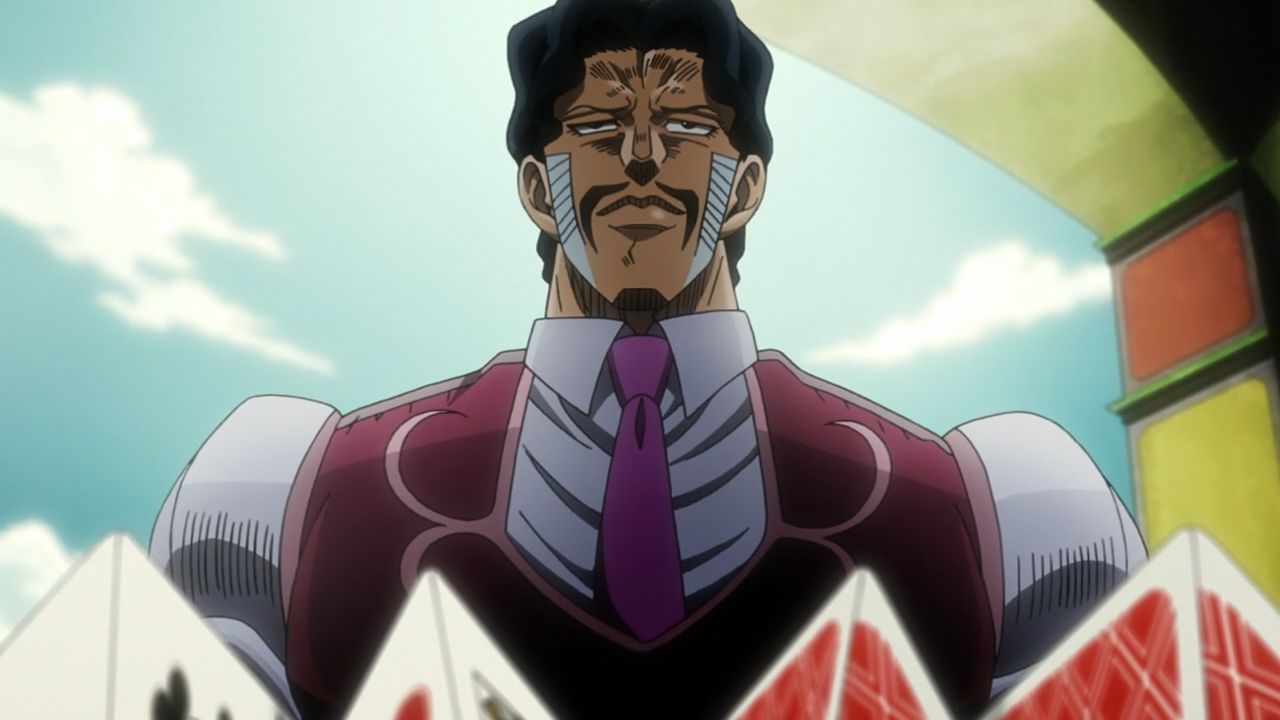
Soon after arriving in Cairo, Jotaro and his friends find a café and ask around about DIO. One mysterious gentleman sitting in the back has some information, but he isn’t willing to give it up unless the group indulges him in a friendly wager. This man is Daniel J. D’Arby, a professional gambler and an agent of DIO. When Jotaro’s ally, Polnareff, loses the gamble, D’Arby’s Stand, known as Osiris, emerges and captures Polnareff’s soul, trapping it in a poker chip.
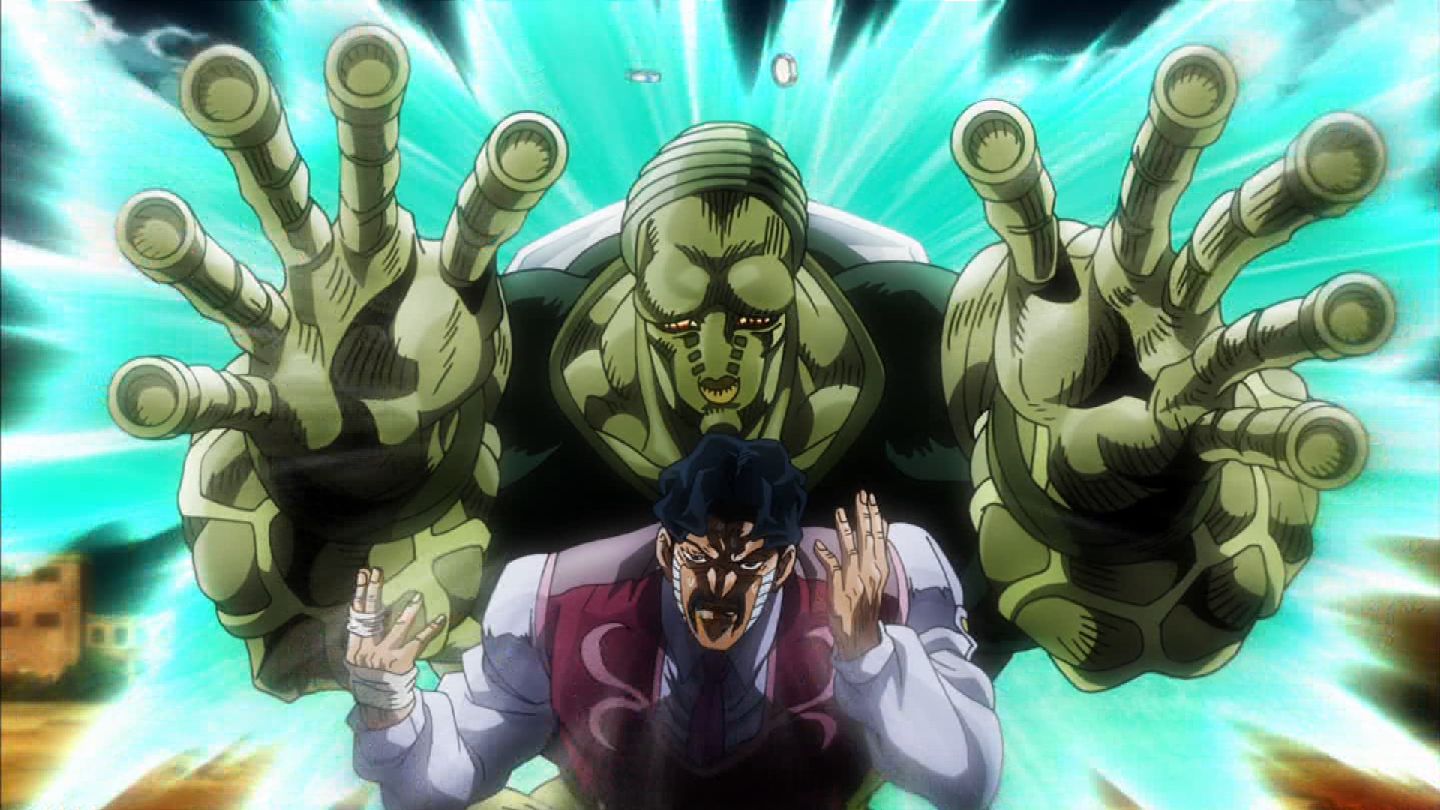
The stakes certainly are high in this one! But let’s take a step back and look at that initial gamble because it establishes some important rules for what’s to come. The wager starts when D’Arby throws two pieces of smoked fish in front of a cat and asks Polnareff to guess which piece the cat will eat first. Polnareff guesses wrong, and then Osiris activates. So we know that D’Arby can only take your soul if you lose a wager against him. What’s more, D’Arby reveals afterward that he owns the cat and trained it to help him cheat at the wager. This establishes that Osiris will function even if D’Arby cheats, so long as his opponents aren’t aware that he’s cheating.
However, that also means that Jotaro and his companions can cheat as well. After D’Arby’s true intentions are revealed, and Polnareff’s life has been put on the line, Jotaro’s grandfather Joseph Joestar steps up and proposes a wager of his own. He fills a cup to the brim with liquor and places some coins on the table. The rules are that both he and D’Arby take turns placing coins into the same cup. The loser is whoever makes the liquid spillover. If Joseph wins, he gets Polnareff’s soul back. But if D’Arby wins, then he gets Joseph’s soul to add to his collection.
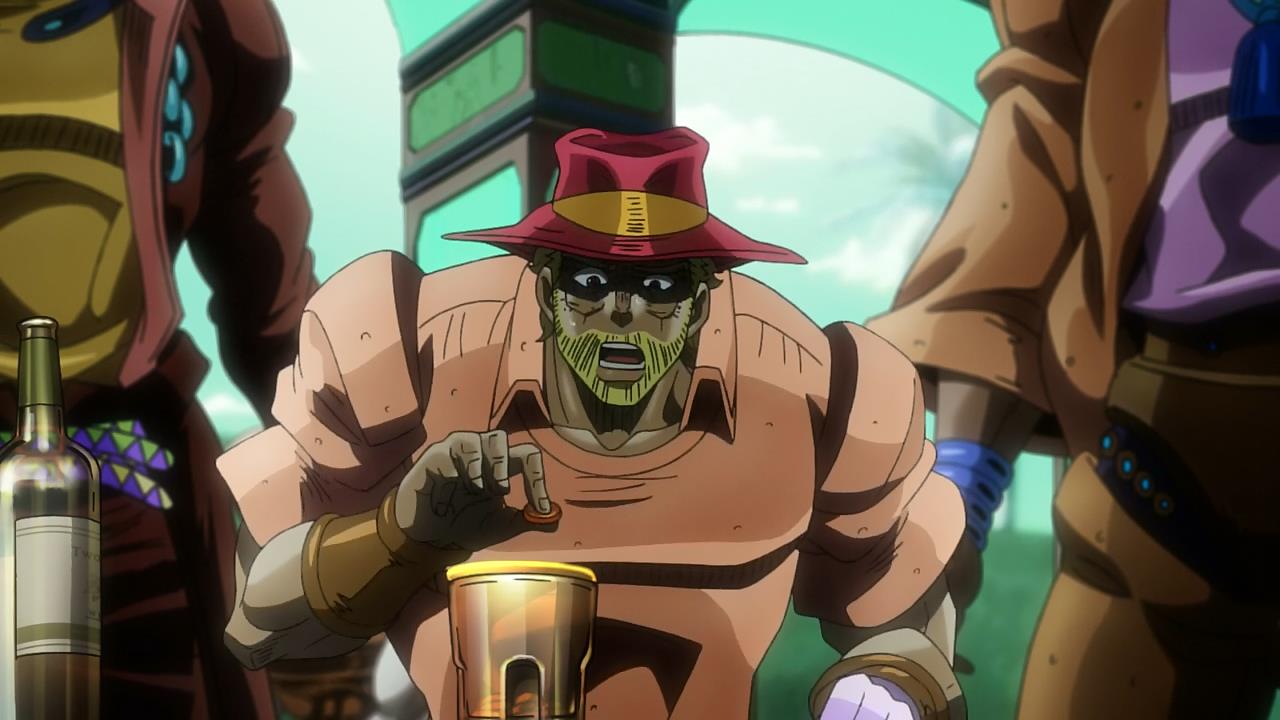
The resulting game is taut, and it’s carried out with all of the shonen anime panache that the show can muster. Both Joseph and D’Arby take advantage of their well-established wit to cheat throughout the course of the game. Joseph holds a tiny piece of alcohol-soaked cotton between his fingers and a coin and squeezes more alcohol into the glass, bringing the surface tension to its breaking point so that the next time D’Arby puts a coin in, it will spill for sure. D’Arby, however, had already placed a small piece of chocolate beneath the glass’s bottom edge, tilting it slightly. He lets the sun melt the chocolate, and the glass is upright again, which allows him to put in one more coin without the surface tension breaking. In this wager’s dramatic conclusion, yet another important rule is revealed: just as Joseph is about to put in the final coin and break the surface tension, he faints, and Osiris takes his soul. D’Arby explains that Joseph had already admitted defeat in his mind and that this is sufficient for Osiris to take a soul.
The Final Round
Finally, Jotaro steps up to the plate and challenges D’Arby to his own game: poker. Before the game starts, Jotaro reveals to D’Arby that his Stand power, Star Platinum, can use its extreme precision to memorize the order of the cards as they’re being shuffled. D’Arby, for his part, can memorize the order of the cards by feel, so the players are at something of an impasse when it comes to cheating one another. When D’Arby tries to manipulate the deck anyway, Jotaro settles the question by breaking his finger with Star Platinum, and they get an impartial young boy to deal the cards for them.
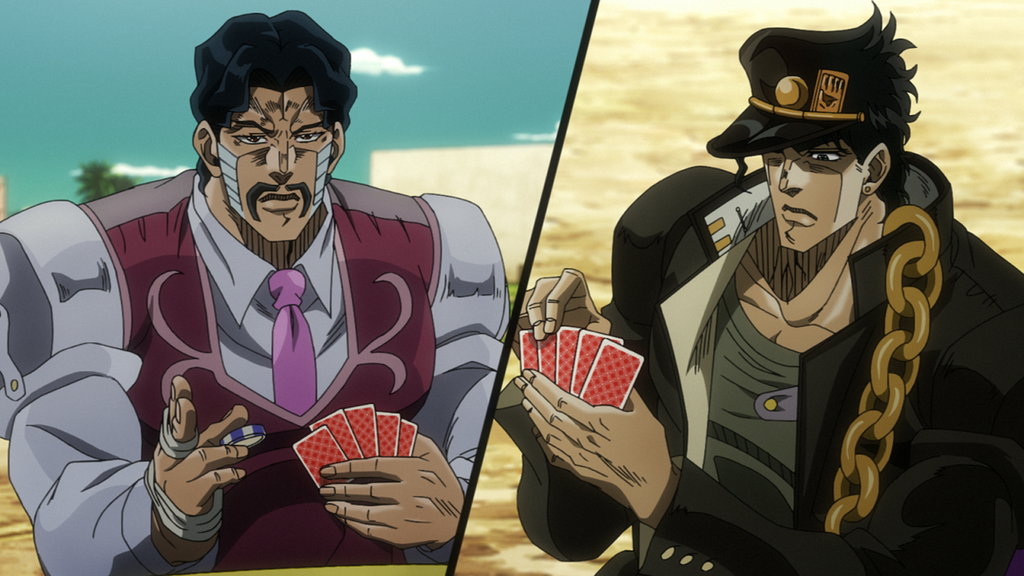
As in the previous games, D’Arby and Jotaro are betting with souls — D’Arby splits Joseph and Polnareff’s souls into six chips each, and Jotaro gets six chips to represent his own soul. The first hand doesn’t go Jotaro’s way, and he loses three of his six chips. Now, Jotaro is really backed into a corner. Time for some desperate measures. When Jotaro is dealt his next hand, he simply leaves his cards on the table, not even looking at them. What’s more, he starts the hand by betting the rest of his soul, as well as the soul of his one remaining companion, Avdol.
D’Arby is completely aware that Jotaro is bluffing. Not only has Jotaro not even looked at his cards, but it’s revealed that the supposedly impartial dealer is actually working for D’Arby — so Jotaro’s cards are guaranteed to be useless. D’Arby, meanwhile, has four kings in his hand. He can’t lose. The stakes keep rising from there. D’Arby matches Jotaro’s bet and then raises the rest of his chips, forcing Jotaro to bet the soul of Kakyoin, a companion who isn’t even there. Meanwhile, Jotaro is acting very strangely: he lights a cigarette and starts smoking for no reason, even summoning Star Platinum for just an instant. D’Arby knows that not even Star Platinum is fast enough to switch all five of Jotaro’s cards, but he still begins to flag under Jotaro’s unbreakable confidence.
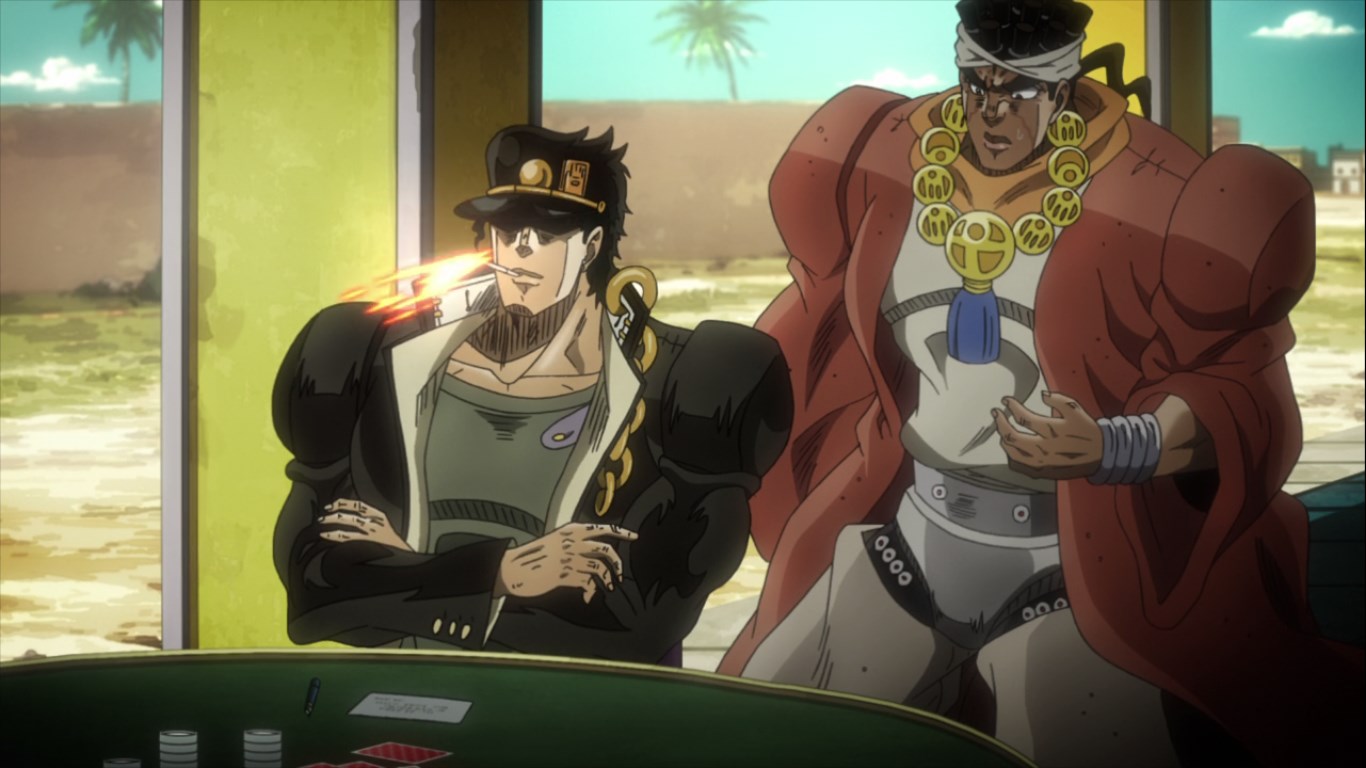
Then, the kicker: Jotaro raises his mother’s soul. At this, D’Arby totally collapses and admits defeat in his mind, losing even though Jotaro had a worthless hand all along. Joseph and Polnareff’s souls return immediately to their bodies, and the group is able to move on in their search for DIO. This encounter is so masterful because each game builds on the rules of the previous round, always exploiting loopholes for surprising conclusions. In the first round, it’s revealed that you can cheat. In the second round, Joseph cheats, but D’Arby cheats better. In the poker game, Jotaro realizes that he can’t cheat, so he simply convinces D’Arby that he could be cheating with such confidence that the enemy collapses under the pressure. The speed and precision of Jotaro’s Stand, of course, are essential to the outcome, as are the iron will and overwhelming confidence for which he’s well-known among shonen anime fans. This poker game is just as gripping as any fight to the death, and it’s the ultimate display of the power of non-combat confrontations in shonen anime.
No Fight, Just Right
So, the next time you’re watching a shonen anime and the characters gear up for some contrived challenge or crazy contest, don’t zone out or fast forward. Instead, think of how the encounter builds specific rules and allows the characters to interact with those rules with their particular set of abilities and personality traits. Maybe, like the candle contest in Hunter x Hunter, the confrontation will allow the characters to find loopholes in the established rules, leading to a surprising finish. Or, like the Davy Back Fight’s Donut Race in One Piece, the encounter will let the characters show off their abilities and equipment in interesting ways.
Better yet, like the “battle” against D’Arby the Gambler in JoJo’s Bizzare Adventure: Stardust Crusaders, the clash might use the character’s abilities to turn the rules completely on their head. All of these techniques, of course, can also be used in shonen anime encounters that involve fighting. All of the best fights in shonen anime do use them, in fact. But it’s only the non-combat encounters that really allow these techniques to shine through in their purest form. That’s why non-combat encounters in shonen anime are so worth paying attention to and learning from. There truly are few better lessons in creating clear narrative tension and excitement for the audience.
